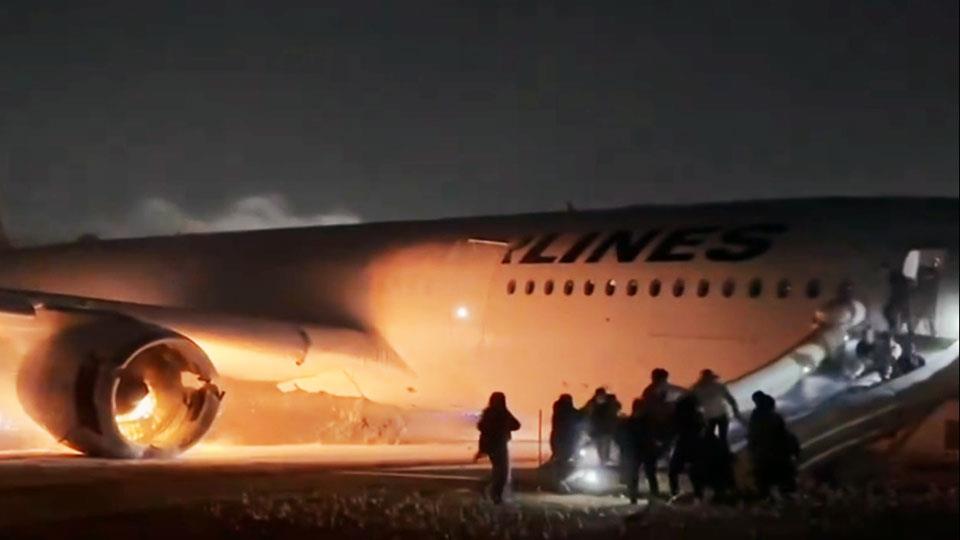
Modern Safety Standards, JAL's Culture Saved Lives In Tokyo Plane Crash
Dhaka: It is a miracle that anyone survived the fiery collision of Japan Airlines (JAL) at Tokyo's Haneda airport. Tragically, five of the six-member crew on the Japan Coast Guard Dash 8 plane died that the JAL passenger plane struck during landing on January 3. However, all the 379 passengers and crew onboard the Airbus A350 of JAL survived the accident. While investigations into what happened in the incident are currently underway, reports cited experts saying that the successful evacuation is down to a combination of modern safety standards and JAL's own rigorous safety culture.
Reports portrayed the message from the aviation industry: it appears to have been the fast reactions of the crew that saved hundreds of lives. Within seconds of the plane coming to a standstill, escape chutes were inflated and those on board were quickly ushered off, even as the cabin filled with smoke.
They cited experts saying they were impressed with the pilots, crew, and passengers for what seemed to have been a textbook evacuation in the most extreme of conditions.
The robust nature of modern aircraft and the training of pilots to handle abnormal situations has developed over decades to a point where the world has the safest period in aviation, added reports citing global aviation stakeholders.
Procedures have been refined as aircraft have got bigger, so all passengers can be evacuated in 90 seconds, reports claimed. Flight attendants on some airlines can also now initiate an evacuation if it is clearly catastrophic, saving vital seconds by not waiting for the captain to initiate it.
It is the influence of cabin crew that get people to evacuate an aircraft, and do so rapidly, mentioned reports.
The safety training that airlines-in this case JAL-put the crews through on a continuous basis paid off allowing for evacuation within 90 seconds. This shows that passengers need to pay attention to the safety briefings and remember that the crews are not glorified food service staff but are well-trained safety professionals.
International minimum safety standards laid out by the International Civil Aviation Organisation mandate cabin crew practice emergency evacuations annually. Aircraft manufacturers must also prove that any new airplane can be fully evacuated in 90 seconds. On top of that, individual airlines can have extra requirements.
What helped to turn Japan Airlines into such a safe airline today was a previous catastrophic accident that happened nearly 40 years ago. On August 12, 1985, a JAL flight from Tokyo to Osaka crashed, killing 520 out of the 524 onboard, following a faulty repair of the tail by Boeing technicians.
The effect was profound on the airline, said reports citing experts. Reports added, in a culture like Japan's, they took that responsibility as a group and wanted to ensure nothing like that ever happened again.
In 2005, realising that many employees were joining the airline without a memory of that accident 20 years ago, JAL opened a space in their corporate HQ displaying parts of the wreckage, as well as stories of the crew and passengers.
Following the accident, about four decades later, till now, the airline has a very strict culture around standard operating procedures and doing everything properly-one of the reasons the crew seemed to have performed so well during the latest accident days ago, said reports citing experts, adding, the successful evacuation is“absolutely” a positive for Japan Airlines.
Recently, JAL was named among the world's safest 25 airlines in an annual listing by website Airlineratings.
“It is top rated as a seven-star airline by our website and has passed all the major safety audits. Also, Japan's airline safety regulator performs better on the eight oversight criteria than the world average for compliance,” said Editor in chief Geoffrey Thomas, as per reports.
- T
Legal Disclaimer:
MENAFN provides the
information “as is” without warranty of any kind. We do not accept
any responsibility or liability for the accuracy, content, images,
videos, licenses, completeness, legality, or reliability of the information
contained in this article. If you have any complaints or copyright
issues related to this article, kindly contact the provider above.


















Comments
No comment